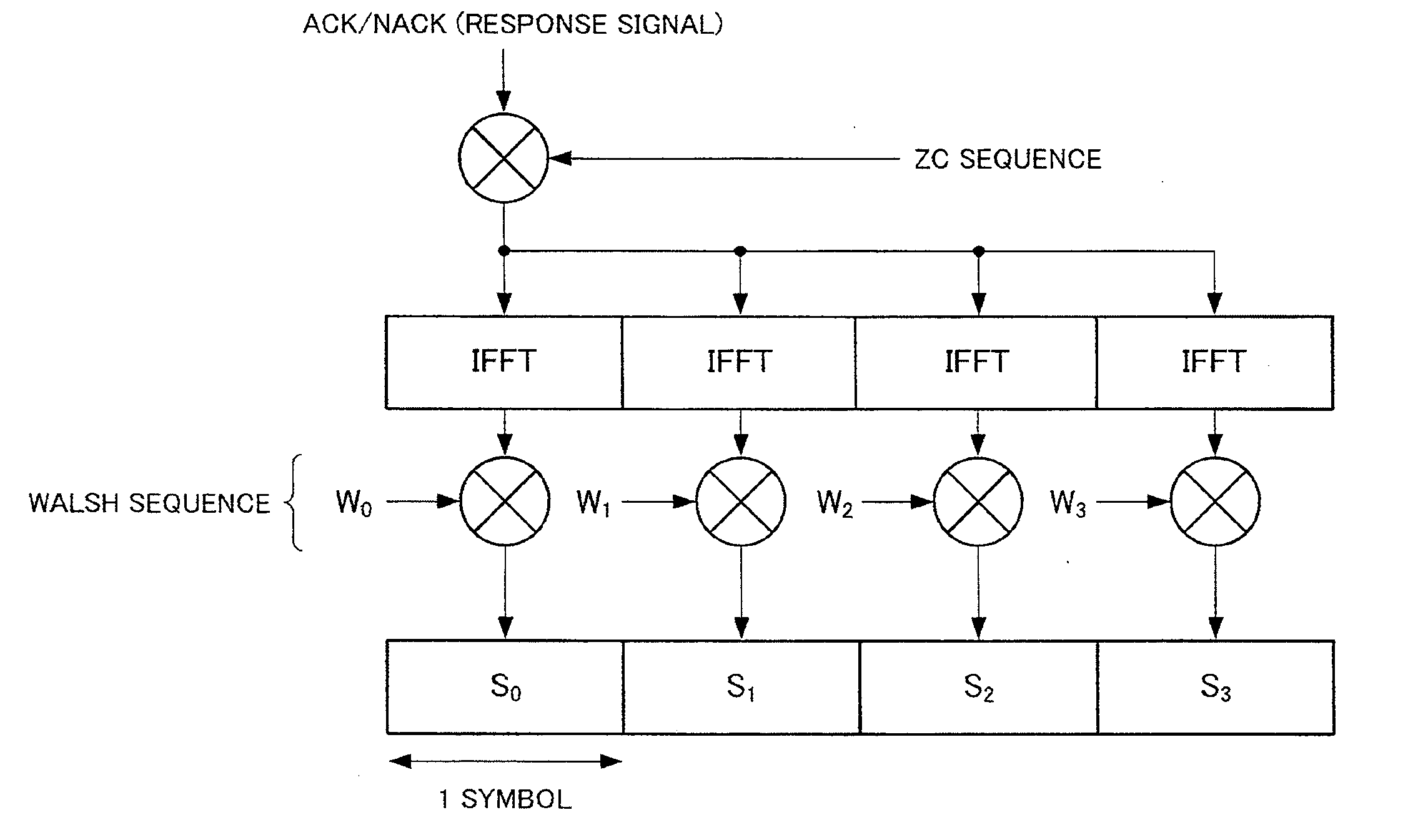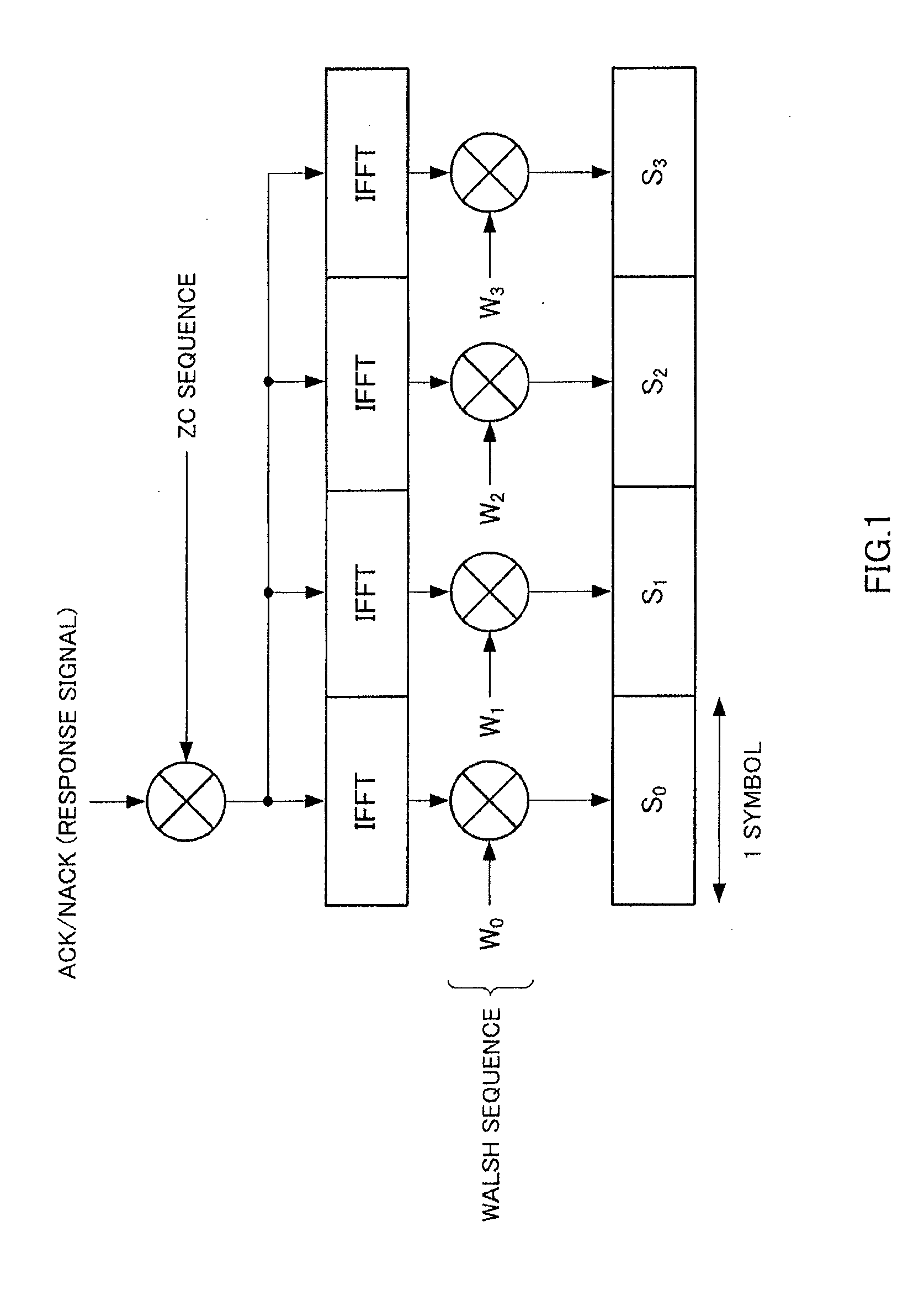Base station apparatus and response signal receiving method
a technology of base station and response signal, applied in the direction of orthogonal multiplex, multiplex communication, wireless communication, etc., to achieve the effect of reducing the degradation of the separation performance of response signals
- Summary
- Abstract
- Description
- Claims
- Application Information
AI Technical Summary
Benefits of technology
Problems solved by technology
Method used
Image
Examples
embodiment 2
[0085]The present embodiment is the same as in Embodiment 1 in allocating an L1 / L2 CCH based on the number of CCE's occupied. Here, the present embodiment differs from Embodiment 1 in using an odd number as the minimum CCE number among the plurality of CCE's when a plurality of CCE's are allocated to one mobile station.
[0086]That is, control information generating section 101 according to the present embodiment allocates L1 / L2 CCH's as shown in, for example, FIG. 7. That is, while, with Embodiment 1 (FIG. 6), L1 / L2 CCH #2 occupies CCE #4 and CCE #5, L1 / L2 CCH #6 occupies CCE #6 and CCE #7, and L1 / L2 CCH #5 occupies CCE #8 to CCE #11, with the present embodiment, by not using CCE #4 as shown in FIG. 7, L1 / L2 CCH #2 occupies CCE #5 and CCE #6, L1 / L2 CCH #6 occupies CCE #7 and CCE #8, and L1 / L2 CCH #5 occupies CCE #9 and CCE #12.
[0087]By performing L1 / L2 CCH allocation as shown in FIG. 7, mobile stations, to which a plurality of CCE's are allocated, always use physical resources for re...
embodiment 3
[0089]The present embodiment further takes into account the collapse of orthogonality between ZC sequences on the cyclic shift axis.
[0090]If the transmission timing difference in mobile stations, the delay time of delay waves or frequency offset increases, inter-code interference is caused between adjacent ZC sequences.
[0091]Therefore, with the present embodiment, as shown in FIG. 9, physical resources for response signals with a high use probability P are not placed adjacently but are placed in a distributed manner.
[0092]That is, for example, referring to the first row (W #0) and the second row (W #1) on the Walsh axis shown in FIG. 9, PUCCH #1 associated with CCE #1 and PUCCH #12 associated with CCE #12 are multiplexed, and PUCCH #2 associated with CCE #6 and PUCCH #11 associated with CCE #7 are multiplexed. Therefore, the sum of the CCE numbers of CCE #1 and CCE #12, “13,” is equal to the sum of the CCE numbers of CCE #6 and CCE #7, “13.” Therefore, according to the present embod...
embodiment 4
[0096]A case will be described with the present embodiment where CCE's are used for both downlink data allocation and uplink data allocation, that is, where a downlink L1 / L2 CCH and an uplink L1 / L2 CCH both occupies CCE's.
[0097]In this case, control information generating section 101 may allocate L1 / L2 CCH's as shown in FIG. 10 or FIG. 11. That is, as in Embodiment 1 (FIG. 6), control information generating section 101 allocates L1 / L2 CCE's in order from the L1 / L2 CCH of the smallest number of CCE's occupied.
[0098]Here, as shown in FIG. 10, control information generating section 101 allocates CCE's in order from the CCE of the lowest CCE number, to downlink L1 / L2 CCH's in order from the downlink L1 / L2 CCH of the lowest channel number, while allocating CCE's in order from the CCE of the highest CCE number, to uplink L1 / L2 CCH's in order from the uplink L1 / L2 CCH of the lowest channel number.
[0099]Alternatively, as shown in FIG. 11, control information generating section 101 allocates...
PUM
 Login to View More
Login to View More Abstract
Description
Claims
Application Information
 Login to View More
Login to View More - R&D
- Intellectual Property
- Life Sciences
- Materials
- Tech Scout
- Unparalleled Data Quality
- Higher Quality Content
- 60% Fewer Hallucinations
Browse by: Latest US Patents, China's latest patents, Technical Efficacy Thesaurus, Application Domain, Technology Topic, Popular Technical Reports.
© 2025 PatSnap. All rights reserved.Legal|Privacy policy|Modern Slavery Act Transparency Statement|Sitemap|About US| Contact US: help@patsnap.com



